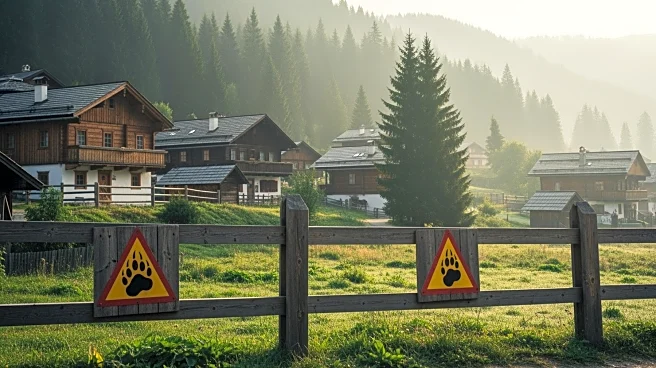What's Happening?
In the Japanese mountain village of Shirakawa, local officials are taking steps to protect residents and tourists from an increasing number of bear sightings and attacks. The village, known for its UNESCO-listed
thatched-roof cottages, has seen a surge in bear activity attributed to a growing bear population and a shortage of natural food sources. Since a bear cub attacked a Spanish visitor last month, authorities have captured six bears using honey-laced traps. Bear sightings have increased significantly, with over 100 incidents reported this year compared to 35 last year. The United States, China, and Britain have issued travel advisories warning of bear attacks in Japan. Measures such as chopping down fruit trees, issuing warnings to walk in groups, and using bear bells are being implemented to deter bears.
Why It's Important?
The rise in bear attacks poses a significant threat to tourism in Japan, particularly in areas like Shirakawa that attract visitors for their cultural heritage sites. The travel advisories issued by major countries could impact tourism, a vital part of Japan's economy. The situation highlights the challenges of managing wildlife in populated areas and the potential consequences for local industries reliant on tourism. The use of innovative solutions like drones equipped with loudspeakers and firecrackers to repel bears reflects the urgency of addressing this issue. The increase in bear population and their encroachment into human settlements may be linked to broader environmental changes, including climate change and rural depopulation.
What's Next?
Authorities in Japan are likely to continue implementing and testing various measures to manage the bear population and ensure the safety of residents and tourists. The use of drones and other rapid-response measures may be expanded to other affected areas. Ongoing monitoring and adjustments to strategies will be necessary to address the root causes of increased bear activity, such as food shortages and habitat changes. Collaboration with environmental experts and wildlife conservationists may be needed to develop long-term solutions.
Beyond the Headlines
The situation in Shirakawa and other parts of Japan raises ethical and environmental questions about human-wildlife interactions. The increase in bear attacks may be symptomatic of larger ecological shifts, including climate change and habitat loss. The ethical considerations of culling bears versus finding non-lethal deterrents are complex and may require public discourse. The cultural significance of bears in Japan and their status as a vulnerable species globally add layers to the conversation about conservation and coexistence.













